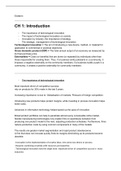Endterm
CH 1: Introduction
- The importance of technological innovation
- The impact of technological innovation on society
- Innovation by industry; the importance of strategy
- The strategic management of technological innovation
Technological innovation = The act of introducing a new device, method, or material for
application to commercial or practical objectives.
Gross domestic product (GDP) = The total annual output of an economy as measured by
its final purchase price.
Externalities = Costs (or benefits) that are borne (or repeated) by individuals other than
those responsible for creating them. Thus, if a business emits pollutants in a community, it
imposes a negative externality on the community members; if a business builds a park in a
community, it creates a positive externality for community members.
- The importance of technological innovation
Most important driver of competitive success.
rely on products for 30% made in the last 5 years.
Increasing importance is due to: Globalisation of markets, Pressure of foreign competition.
Introducing new products helps protect margins, while investing in process innovation helps
lower costs.
Advances in information technology helped speed up the pace of innovation.
Broad product portfolios can help to penetrate almost every conceivable niche market,
flexible manufacturing technologies now enable firms to seamlessly transition from
producing one product model to the next, adjusting production schedules. Furthermore, firms
reduce production costs by using common components in many of the models.
The results are greater market segmentation and rapid product obsolescence.
A firm that does not innovate quickly finds its margins diminishing as its products become
obsolete.
§Innovation is the implementation of creative ideas into some new device or process.
§Requires combining creativity with resources and expertise.
§Technological innovation now the single most important driver of competitive success in many
industries
,§Many firms earn over one-third of sales on products developed within last five years
§Product innovations help firms protect margins by offering new, differentiated features.
§Process innovations help make manufacturing more efficient.
§Advances in information technology have enabled faster innovation
§CAD/CAM systems enable rapid design and shorter production runs
§Importance of innovation and advances in information technology have lead to:
§Shorter product life cycles (more rapid product obsolescence)
§More rapid new product introductions
§Greater market segmentation
- The impact of technological innovation on society
Innovation enables a wider range of goods and services to be delivered to people worldwide.
It has made production more efficient.
The aggregate impact of technological innovation can be observed by looking at gross
domestic product.
Growth in GDP could not be accounted for entirely by growth in labor and capital inputs.
Solow argued that this unaccounted for residual growth represented technological change:
technological innovation increased the amount of output achievable from a given quantity of
labor and capital. Thus, to the extent that goods improve quality of life we can ascribe some
beneficial impact of technological innovation.
However, it sometimes results in negative externalities. But technological innovation in its
purest essence, knowledge , is there to solve our problems and pursue our goals.
Technological innovation is thus the creation of new knowledge that is applied to practical
problems, Sometimes it is applied to problems hastily, without full consideration of the
consequences and alternatives. But more knowledge is better than less.
§Innovation enables a wider range of goods and services to be delivered to people worldwide
§More efficient food production, improved medical technologies, better transportation, etc.
§Increases Gross Domestic Product by making labor and capital more effective and efficient
§However, may result in negative externalities,
E.g., pollution, erosion, antibiotic-resistant bacteria
- Innovation by industry; the importance of strategy
,Many firms charge headlong into new product development without clear strategies or well
developed processes for choosing and managing projects. Such firms often initiate more
projects than they can effectively support, choose projects that are a poor fit with the firm’s
resources and objectives, and suffer long development cycles and high project failure rates
as a consequence. Successful innovators have clearly defined innovation strategies and
management processes.
The innovation funnel
Most innovative ideas do not become successful new products, only 1 in 9 projects that are
initiated are successful. It takes 3000 raw ideas to produce one significantly new and
successful commercial product. The innovation process is thus often conceived of as a
funnel, with many potential new product ideas going in the wide eng, but very few making it
through the development process.
§Successful innovation requires carefully crafted strategies and implementation processes.
§Innovation funnel
§Most innovative ideas do not become successful new products.
§E.g., The New Product Development Funnel in Pharmaceuticals
- The strategic management of technological innovation
A firm’s new product development process should maximize the likelihood of projects being
both technically and commercially successful. To achieve these things, a firm needs
(a) an in-depth understanding of the dynamics of innovation,
- CH2; Sources of innovation
- CH3; Types and patterns of innovation
- CH4; Standards Battles and design dominance
- CH5; Timing of entry
(b) a well-crafted formulated innovation strategy, and
- CH6; Defining the organization’s strategic direction
- CH7; Choosing innovation projects
- CH8; Collaboration strategies
- CH9; Protecting innovation
(c) well-designed processes for implementing the innovation strategy.
- CH10; Organizing for innovation
- CH11; Managing the new product development process
- CH12; Managing new product development teams
- CH13; Crafting a deployment strategy
Innovation management is the art and science of managing the process of implementation of
ideas into valuable products, process or services
, CH 2: Industry dynamics of technological
innovation
- Overview
- Creativity
- Translating creativity into innovation
- Innovation in collaborative networks
Innovation = The practical implementation of an idea into a new device or process
Idea = Something imagined or pictured in the mind
Creativity = The ability to produce novel and useful work
Intranet = A private network, accessible only to authorized individuals. It is like the internet
but operates only within (intra) the organization.
Basic research = Research targeted at increasing scientific knowledge for its own sake. It
may or may not have any long term commercial application.
Applied research = Research targeted at increasing knowledge for a specific application or
need.
Development = Activities that apply knowledge to produce useful devices, materials, or
processes.
Complementors = Producers of complementary goods or services (eg, for video game
console producers such as Sony or Nintendo, game developers) are complementors.
Absorptive capacity = The ability of an organization to recognize, assimilate, and utilize
new knowledge.
Technology transfer offices = Offices designed to facilitate the transfer of technology
developed in a research environment to an environment where it can be commercially
applied.
Science parks = Regional districts, typically set up government, to foster R&D
collaborations between government, universities, and private firms.
Incubators = Institutions designed to nurture the development of new businesses that might
otherwise lack access to adequate funding or advice.
Technology clusters = Regional clusters of firms that have a connection to a common
technology, and may engage in buyer, supplier, and complementary relationships, as well as
research collaboration.
Complex knowledge = Knowledge that has many underlying components, or many
interdependencies between those components, or both.
Tacit knowledge = Knowledge that cannot be readily codified (documented in written form).
Agglomeration economies = The benefits firms reap by locating in close geographical
proximity to each other.
Knowledge brokers = Individuals or organizations that transfer information from one
domain to another in which it can be usefully applied.
Technological Spillovers = A positive externality from R&D resulting from the spread of
knowledge across organizational or regional boundaries.





